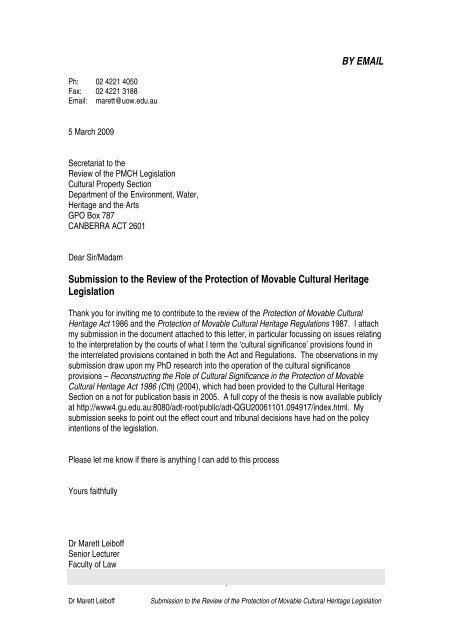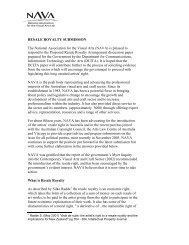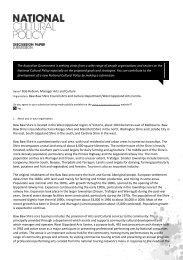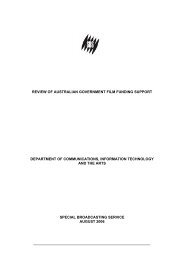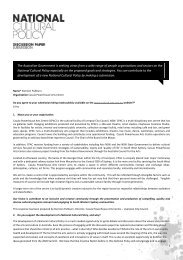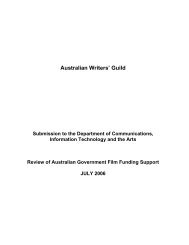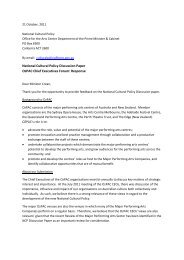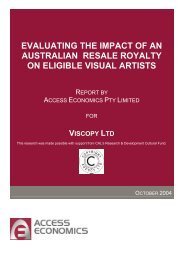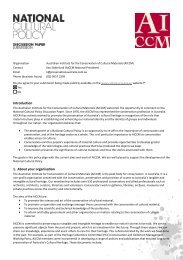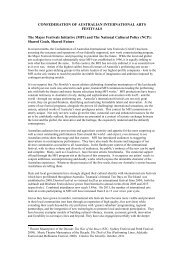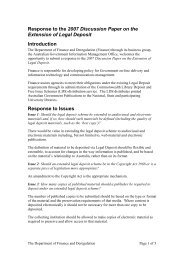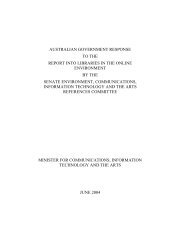Leiboff, Dr Marett (38 KB PDF)
Leiboff, Dr Marett (38 KB PDF)
Leiboff, Dr Marett (38 KB PDF)
You also want an ePaper? Increase the reach of your titles
YUMPU automatically turns print PDFs into web optimized ePapers that Google loves.
BY EMAILPh: 02 4221 4050Fax: 02 4221 3188Email: marett@uow.edu.au5 March 2009Secretariat to theReview of the PMCH LegislationCultural Property SectionDepartment of the Environment, Water,Heritage and the ArtsGPO Box 787CANBERRA ACT 2601Dear Sir/MadamSubmission to the Review of the Protection of Movable Cultural HeritageLegislationThank you for inviting me to contribute to the review of the Protection of Movable CulturalHeritage Act 1986 and the Protection of Movable Cultural Heritage Regulations 1987. I attachmy submission in the document attached to this letter, in particular focussing on issues relatingto the interpretation by the courts of what I term the ‘cultural significance’ provisions found inthe interrelated provisions contained in both the Act and Regulations. The observations in mysubmission draw upon my PhD research into the operation of the cultural significanceprovisions – Reconstructing the Role of Cultural Significance in the Protection of MovableCultural Heritage Act 1986 (Cth) (2004), which had been provided to the Cultural HeritageSection on a not for publication basis in 2005. A full copy of the thesis is now available publiclyat http://www4.gu.edu.au:8080/adt-root/public/adt-QGU20061101.094917/index.html. Mysubmission seeks to point out the effect court and tribunal decisions have had on the policyintentions of the legislation.Please let me know if there is anything I can add to this processYours faithfully<strong>Dr</strong> <strong>Marett</strong> <strong>Leiboff</strong>Senior LecturerFaculty of Law1<strong>Dr</strong> <strong>Marett</strong> <strong>Leiboff</strong>Submission to the Review of the Protection of Movable Cultural Heritage Legislation
Submission to the Review of the Protection of MovableCultural Heritage Legislation<strong>Dr</strong> <strong>Marett</strong> <strong>Leiboff</strong>Faculty of LawUniversity of WollongongIntroductionThe purpose of my submission is to point out the effect court and tribunal decisions have hadon the policy intentions of the Protection of Movable Cultural Heritage Act 1986 (‘the Act’) andthe Protection of Movable Cultural Heritage Regulations 1987 (‘the regulations’) with respect tothe operation of its ‘cultural significance provisions’. 1 In the only Federal Court decisionconcerning the legislation, Black CJ and Gummow J in Waterhouse v Minister for the Arts andTerritories, 2 held that ‘the Act operates upon established common law concepts of ownershipand possession of chattels’. 3 This principle was taken forward into the leading AdministrativeAppeals Tribunal (‘AAT’) decision of Re Truswell and Minister for Communications and theArts, 4 which imposed a bifurcated system - physical objects would be treated as tangibles (orchattels) while their meaning or value would be treated as intangibles (analogous to intellectualproperty law). 5 Whether used in practice or not, this case added a layer of interpretation tothe cultural significance provisions which does not accord with contemporary practices used toassess the cultural significance of objects, and which, as I have argued elsewhere, has thepotential to allow objects to be misread and misinterpreted. 6It is also apparent that the web of interrelated provisions established by the ‘culturalsignificance provisions’ is complex and if used literally, imposes multiple layers of interpretationthat had not been intended by the framers of the structure, 7 who intended that the List wouldbe used to decide an object’s relative cultural significance. 8 Yet the cases tells us the locus of1 I use the term the ‘cultural significance provisions’ to refer to the web of provisions - sections 7, 8 and 10 of theAct and the National Cultural Heritage Control List located in Schedule 1 of the regulations (‘the List’) decidewhether objects should or should not be granted export permits2 (1993) 119 ALR 89.3 (1993) 119 ALR 89, 95.4 (1996) 42 ALD 2755 Re Truswell and Minister for Communications and the Arts (1996) 42 ALD 275, 294 [119] – [120].6 For a fuller exploration of this issue see <strong>Marett</strong> <strong>Leiboff</strong> ‘Law's Empiricism of the Object: How Law RecreatesCultural Objects in its Own Image’ (2007) 27 Australian Feminist Law Journal 23.7 See especially the twin cases of Re Jacklin and the Minister for the Arts and the Centenary of Federation [2001]AATA 416 and Re Jacklin and the Minister for the Arts and the Centenary of Federation [2001] AATA 4178 Protection of Movable Cultural Heritage Bill 1985 (Cth) Explanatory Memorandum, Clause 8: National CulturalHeritage Control List:2<strong>Dr</strong> <strong>Marett</strong> <strong>Leiboff</strong>Submission to the Review of the Protection of Movable Cultural Heritage Legislation
decision-making about the status of an object occurs through the application of sections 7 andsection 10 (6) alone; that the List only has a function as a preliminary filter to establish if theobject is then to be assessed against sections 7 and section 10 (6). 9 In particular, ReTruswell and Minister for Communications and the Arts, 10 stands for the proposition that theList is used to merely identify the object as a physical type, 11 meaning that the List is merely adescriptive listing of objects. It only acts as a first step to the object’s further assessment undersection 10 (6). 12 Thus, it is possible for mistakes to be made because the locus of decisionmakingshifts between too many platforms.For this reason, I have argued that the only way to correct the problems created through thesedecisions is to reframe how cultural significance is ascribed and assessed under the legislation,by replacing the multi-platform method with an accepted form of cultural significanceassessment, 13 as adapted from time to time. Thus my submissions under each of the followingheadings are made with this position in mind.The List will be based on the categories given in clause 7 and will set out for each category those criteriawhich will be used to determine whether or not an object falling within that category may be judged to beof such importance that its loss would significantly diminish the cultural heritage of Australia.(emphasisadded)9 Re Best and Minister for the Arts and Administrative Services (1994) 36 ALD 343; Re J B Hawkins Antiques andMinister for Communications and the Arts (1995) <strong>38</strong> ALD 323; Re Blake and Brain and Minister forCommunications and the Arts (1995) <strong>38</strong> ALD 333; Re Truswell and Minister for Communications and the Arts(1996) 42 ALD 275; Re Hawkins and the Minister for the Arts and Centenary of Federation [2001] AATA 304; ReJacklin and the Minister for the Arts and the Centenary of Federation [2001] AATA 416; Re Jacklin and theMinister for the Arts and the Centenary of Federation [2001] AATA 417; Re Hooper and Minister, Department ofEnvironment and Heritage [2005] AATA735.10 Re Truswell and Minister for Communications and the Arts (1996) 42 ALD 275, 291 - 292 [106] – [107].11 Re Truswell and Minister for Communications and the Arts (1996) 42 ALD 275, 291 [106].12 Re Truswell and Minister for Communications and the Arts (1996) 42 ALD 275, 291 - 292 [106] – [107].13 Jacklyn <strong>Marett</strong> <strong>Leiboff</strong>, Reconstructing the Role of Cultural Significance in the Protection of Movable CulturalHeritage Act 1986 (Cth) (2004), unpublished PhD thesis,Chapter 7http://www4.gu.edu.au:8080/adt-root/public/adt-QGU20061101.094917/index.html3<strong>Dr</strong> <strong>Marett</strong> <strong>Leiboff</strong>Submission to the Review of the Protection of Movable Cultural Heritage Legislation
1. National Cultural Heritage Control List1.1 Scope of the ListWhatever decisions are made about which objects are to be included in the List, itneeds to be kept in mind that the List does not just function against the needs of thoseindividuals or organisations who actively ‘use’ it. Being ‘listed’ means that objects canbe returned to Australia if they have been exported without a permit, so to removeobjects from the List simply because they are not ‘used’ would mean that Australiawould not be able to have objects returned in these circumstances. 141.2 Adequate representationAs the AAT decisions made after the refining provisions were inserted in theregulations show, 15 tests like this are virtually unworkable, especially because theyhave the tendency to allow applicants to emphasise the physical characteristics of theobjects rather than their significance factors.2. Thresholds and the PMCH Regulations2.1 Age thresholdsAge thresholds are problematic for the reasons set out in the Discussion Paper;however, the issue of the physical state of an object through its life needs to beaddressed to overcome the decision in Re Blake and Brain and Minister forCommunications and the Arts, 16 where alterations to the object in question, and itschanged usages, were able to be used to deny its cultural significance. 172.2 National significanceA new category of objects of national significance should be introduced.2.3 Monetary ThresholdsSee my observations at 1.114 Protection of Movable Cultural Heritage Act 1986 section 9, and see <strong>Leiboff</strong> above n 13, pp 78 – 79 and pp 125– 129.15 Re Hawkins and the Minister for the Arts and Centenary of Federation [2001] AATA 304; Re Jacklin and theMinister for the Arts and the Centenary of Federation [2001] AATA 416; Re Jacklin and the Minister for the Artsand the Centenary of Federation [2001] AATA 417; Re Hooper and Minister, Department of Environment andHeritage [2005] AATA735.16 (1995) <strong>38</strong> ALD 333.17 <strong>Leiboff</strong> above n 13, especially Chapters 4 and 74<strong>Dr</strong> <strong>Marett</strong> <strong>Leiboff</strong>Submission to the Review of the Protection of Movable Cultural Heritage Legislation
3. Significance and the PMCH Regulations to Australia3.1 Significance AssessmentThe outcome of my PhD research into the law in this area showed that the culturalsignificance provisions would be made more workable by adopting the methods usedin Significance. I would therefore submit, for the reasons set out in that research, thatthe definition of ‘significance to Australia’ be repealed, and that the tests used inSignificance replace the ‘relativity’ test set out in s7 and s 10 (6) of the legislation. Acorrective must also be found to negative the effect of the AAT decisions, which havefound the List is not used as a decision-making tool, but acts merely as a listing ofobjects which have the potential to be refused an export permit.Any redrafting of s 10 (6) should ensure that it conforms to Australia’s obligation underthe 1970 UNESCO Convention under which the legislation is established, but whichmakes it apparent that the multilayered assessment methods imposed by thelegislation are replaced by this ‘one-step’ test. For this reason, either the Significancetest needs to be placed within the body legislation itself, or alternatively, an enablingprovision be inserted into the main body of the legislation to ensure that theSignificance test included in the List is given the validity needed under s 7 and s 10 (6)of the Act. Models can be found in the Broadcasting Services Act 1992, where theSchedules of that Act are ‘given effect’ enabling them to operate as ‘mini-Acts’ on theirown. I would suggest that the List be given its own Schedule along the lines of theBroadcasting Services Act 1992 model of ‘semi-autonomous’ Schedules.Conversely, it seems to me that it is an oddity that the Australian process does notprovide decisions and reasons why objects are granted export permits; it would helpassist applicants and the community know why some objects are not so important thatthey can be allowed to leave the country. The Reports produced with respect to theoperation of the Waverley rules provide an informative and helpful guide to thereasoning used to decide why some objects are so important that they must remain inthe United Kingdom.6. Export Permit Applications6.1 ApplicantsObjects can be described in many different ways and their value ‘talked’ up or downdepending on the audience and purpose. 18 If it is decided that applicants should berequired to provide more information in their applications, then the New Zealandapproach is an excellent model to be used, but with one modification. I would suggestthat the legislation be amended to include a range of matters that applicants also beexpected to provide, and these should include as applicable, the provision of any pre-18 <strong>Leiboff</strong> above n 6; <strong>Leiboff</strong> above n 13 especially pp 314 – 315, pp 375 - <strong>38</strong>05<strong>Dr</strong> <strong>Marett</strong> <strong>Leiboff</strong>Submission to the Review of the Protection of Movable Cultural Heritage Legislation
sale publicity, including catalogue entries, media commentary and the like, as part oftheir application. The usual penalties for providing misleading information under theCriminal Code Act (Cth) would apply; and in the ‘google age’ it is now very easy totrack this kind of information, thus deterring false declarations.8. Expert Examiners8.1 Five year review and trainingA five yearly review would give the National Cultural Heritage Committee (‘theCommittee’) scope to remove from the register expert examiners who have not, forexample, undergone cultural significance assessment training. As my research hasshown, 19 the existence of an ‘outrider’ assessment can lead to applications forreview. 20Such training should be compulsory, to ensure that assessors are undertakingassessment using the methods established by the legislation. While meant to beadvisory only, applicants clearly see value in an ‘agreeable’ assessment, using this asleverage for seeking a review. These outrider assessments are used as evidence inany review process. I would suggest that the legislation be amended to excludeassessments that do not conform to the tests set out in the legislation, meaning thatthe Committee and Minister would not have to include any reference to them in thedecision to refuse an export permit. Of course, validly assessed reportsrecommending the export permit be granted would not be excluded. Irrespective, anapplicant should not be refused a copy of any discarded reports, but it would alert theAAT to the reasons why the assessment had not been used to assess the culturalsignificance of the object in the first place.10. Enforcement Issues10.1 EPBC ActThese proposals appear to be sensible, but would need to be worked in and aroundthe existing enforcement regime. Any changes made, however, would have toconform to Australia’s obligations under the 1970 UNESCO Convention.10.2 AAT ReviewAt present, no delegations of any substance are accommodated under the Act, as onlythe Minister is able to decide whether objects will be refused export permits. Thiswould potentially remove any grounds of review to an applicant, as only reviews on the19 <strong>Leiboff</strong> n 17 above20 <strong>Leiboff</strong> above n 136<strong>Dr</strong> <strong>Marett</strong> <strong>Leiboff</strong>Submission to the Review of the Protection of Movable Cultural Heritage Legislation


